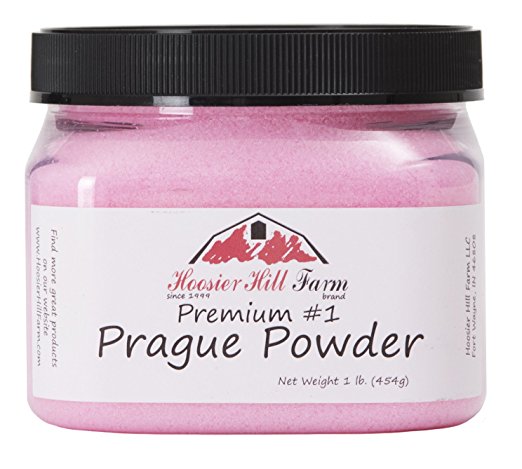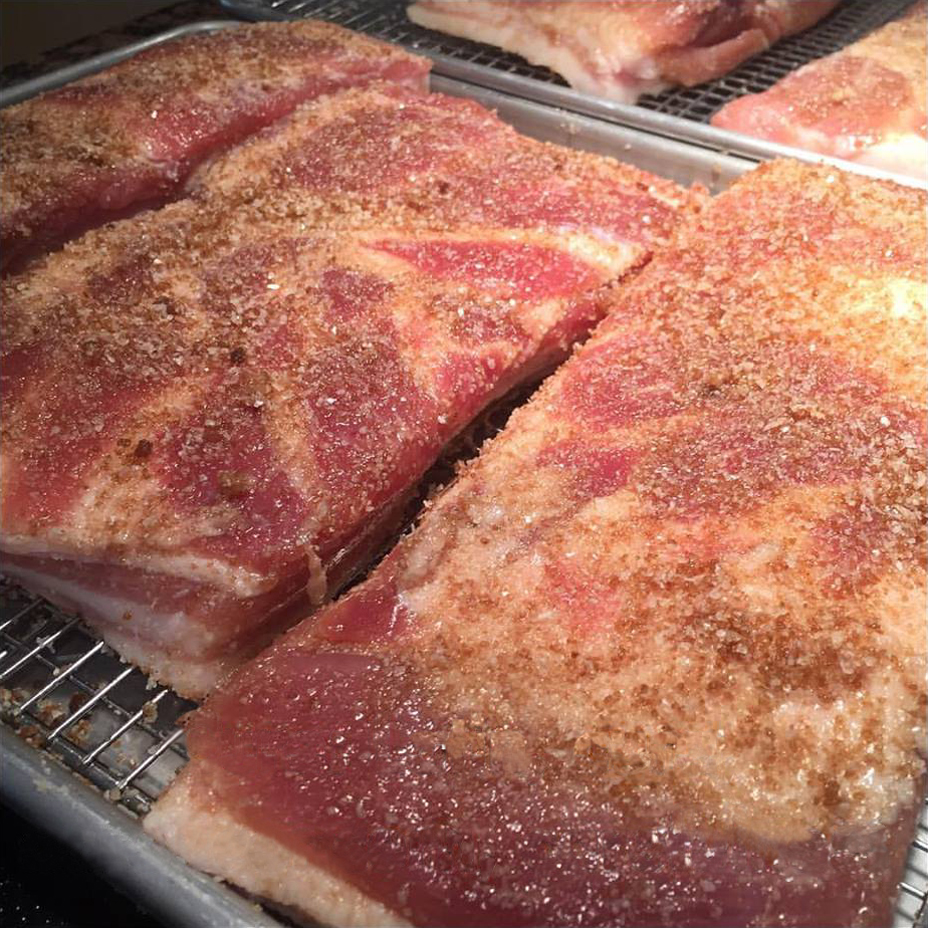How Much Curing Salt Forground Beef
Curing salts, as well known as Prague Powder are essential in nutrient preservation. We know that salt is a valuable preservative all the same information technology isn't constructive at killing all microorganisms that tin can spoil food. Curing salt is usually a blend or salt also as sodium nitrite or sodium nitrite that have special preservative qualities.
The two types of curing salt we will address in this article are:
- Prague Pulverization #1
- Prague Powder #2
These 2 curing salts are referred to under lots of names but are e'er typically denoted as #one or #2. The names yous may find range through the following:
- Curing Salt #1 / #2
- Instacure
- Tenderquick
- Pinkish Table salt
In a moment nosotros volition go onto just what curing salts are and how they are used to preserve meat. Before the apply of curing salts, even so, ordinary table salt was used on its own as a means to preserve nutrient.
Table salt has been used for thousands of years to preserve food and being able to store food for longer periods meant humans could thrive during periods when nutrient isn't readily available or when travelling to new, unexplored lands. Human being Civilisation was congenital upon humans being able to preserve nutrient and along with drying and smoking, salt was a key ingredient in early human being success.
In fact, common salt was so valuable to early societies it was one of the first international merchandise commodities and used every bit currency along with the food sources similar common salt cod or salted meats that salt help produce.
Table salt As A Preservative

The key aspect of salt as a preservative is that it draws moisture out of the food via osmosis. Most microorganisms, moulds and leaner that will spoil food or make you lot sick cannot survive in an environment with table salt every bit the salt dehydrates them.
Salting food either by directly rubbing salt onto the surface of the food or by making a brine by mixing salt with water and then submerging the nutrient in the brine are both methods that preserve the nutrient, primarily by dehydration.
Common salt + Nitrites = Ameliorate
The trouble with using salt alone as a cure is that some bacteria are able to survive in a saline environment. Clostridium botulinum bacteria that produce the toxin that causes botulism is not suppressed by salt and tin can even survive at high temperatures afterward cooking. Information technology should exist noted however salt is used in conjunction with other preservation methods without nitrites, such as when making beefiness jerky.
Sodium nitrate and Sodium nitrite both cease the growth of botulism causing bacteria and are used in the production of cured meats commercially throughout the world.
Curing salts are a combination of salt and either a pocket-size amount of sodium nitrate or sodium nitrite as well every bit a scarlet dye that make the common salt look pink. These curing salts are very economic to apply and are the best mode to make cured food safe.
Rather confusingly there are multiple names for curing salts and many companies have trademarked names so the range of products is a trivial confusing to the newcomer. A guide to some of the names of curing salts tin be found hither.
Sourcing Curing Salts
When you are ownership curing salts such as Prague pulverisation #1 or #2 / Instacure etc. it is important that y'all understand what exactly you are buying. Curing salt such as sodium nitrate or nitrite need to be used as only a tiny amount of the salt used. These curing salts are mixed with regular tabular array salt and carbohydrate to form a curing mix.
When buying your curing salts information technology is important to carefully follow the instructions from the supplier to ensure you are mixing the salts in the correct quantities for the amount of meat y'all are curing.
A Note About Nitrites
The pinkish dye is only for identification purposes and has no flavour or colour effect in the preserved food. The reason why curing salt needs to exist easily identifiable is considering nitrates can be toxic if used at above-recommended levels.
It should exist noted that nitrites are commonly found in foods we all consume every twenty-four hours. Leafy vegetables are a large source of nitrites and vegetables similar celery and spinach can contain upward to 10 times more nitrites than cured meat.
If you use curing salts at the recommended levels the is no danger and so always be certain to follow the instructions on the parcel or from a reliable recipe.
I highly recommend an accurate scale to measure curing salts, with this simple scale you can mensurate the precise amounts needed.
Nitrates & Nitrites In Curing Table salt
Both sodium nitrate and nitrite are used primarily for their bacteria inhibiting properties simply they also have other benefits.
Colour: Foods like meat that are cured with table salt lone tend to go lose their colour and turn an unappealing greyness. The reason why uncooked meat is red is to do with a paint called myoglobin which stores oxygen in the cells of the muscle. When we melt a piece of meat the myoglobin loses its store of oxygen and this is why it changes colour. The same thing happens when y'all salt the meat, the oxygen is removed and the colour of the meat changes.
When using nitrites or nitrate the oxygen in the myoglobin is replaced by the nitrate then the colour of the meat stays a deep red both before and later on cooking. If y'all await at a slice of corned beef or salted beef information technology has been cooked for a couple of hours in most cases just withal retains a deep red colour.
Preserve: Nitrates and nitrites are known to inhibit and stop the growth of almost all food spoiling leaner including the ones that common salt alone cannot. This is very important to nutrient prophylactic and if you are intending to cure any meat for periods of more than a few days. fifty-fifty if information technology is cooked subsequently curing you will want to use curing salts with added nitrites.
Meat that is cured for longer periods like salami or hams that oftentimes are cured just not cooked is usually preserved with nitrates also as nitrites which work in combination. Over time the nitrates break down into nitrites which go on leaner from growing for the much longer periods that the meat is cured.

Types of Curing Salt
There are ii main types of curing salts that take applications for dissimilar kinds of curing. Meat that is cured over a short period of time and then cooked afterwards needs a different type of cure to a meat that is cured over many months or years and frequently eaten raw, such as, salami or air dried hams similar Serrano or prosciutto.
Depending on where you lot live in the world in that location may exist different names but well-nigh often they are numbered either #1 or #2.
Prague Powder #1
Also sold under the name Instacure #ane, Pink Curing Salt #1 or Quick Cure. Prague powder #1 is a combination of half-dozen.25% sodium nitrite and 93.75% salt (sodium chloride) and usually some anti caking agents too as pink dye. The dye is added to make it obvious that the salt has nitrites in it and serves no purpose in terms of flavouring or colouring your cures.
Prague Powder #1 works quickly to cure meat and is applicable to apply on meats that are cured over a brusque menstruum. Products similar bacon, sausage, ham or corned beef that is cured then cooked before existence consumed are cured with Prague powder #1.
Dosage of Prague Pulverisation #1
Curing salts like Prague powder #1 are very effective and but small amounts are needed to cure a slice of meat. Recommended levels are around 1 teaspoon of curing common salt per 5lb (two.27kg) of meat, that is effectually two.5 grams per kg of meat. Always follow the directions provided by the manufacturer.
Prague Powder #two
Also sold as Instacure #2, or Deadening Cure. Prague powder #two is a combination of 6.25% sodium nitrite, 4.75% sodium nitrate and 89% salt as well as pink dye and some anti caking agents.
The key difference between the two curing salts is the prague powder #2 has the boosted sodium nitrate also as sodium nitrite found in prague powder #1. This addition is skilful for curing meats over long periods. Products like salami, air dried hams such every bit prosciutto or serrano ham. The preserving power of prague powder #2 lasts over months every bit the nitrates slowly convert to nitrites as the meat cures.
Dosage of Prague Powder #2
Prague powder is used at the same rates as prague pulverization #1 then one tsp is plenty for 5lb (2.27kg) of meat. That is 2.5 grams per kg of meat.

Usage of Curing Salts
Every bit you tin tell from the dosage of both types of curing salt a little amount is very effective. Most recipes will specify how much curing salt is needed to cure the piece of meat you are working with. This curing salt will be mixed with regular kosher salt or sea common salt to make upwardly the whole amount of the cure.
Information technology is very important to follow recipes closely, every bit mentioned previously curing salt is toxic above recommended levels. Make sure you have a good set of authentic scales when measuring your curing salts so you lot know the verbal dosages making it perfectly safe to consume cured products.
Curing Salt Reckoner
If yous are having trouble calculating how much curing table salt to utilize for the corporeality of meat you intend to cure then I would suggest using an online calculator. This particular calculator from EatCuredMeat.com is really precise and the level of information provided is really helpful in club to sympathise how to set up cures and brines.
Source: https://preserveandpickle.com/curing-salts-prague-powder/
0 Response to "How Much Curing Salt Forground Beef"
Post a Comment